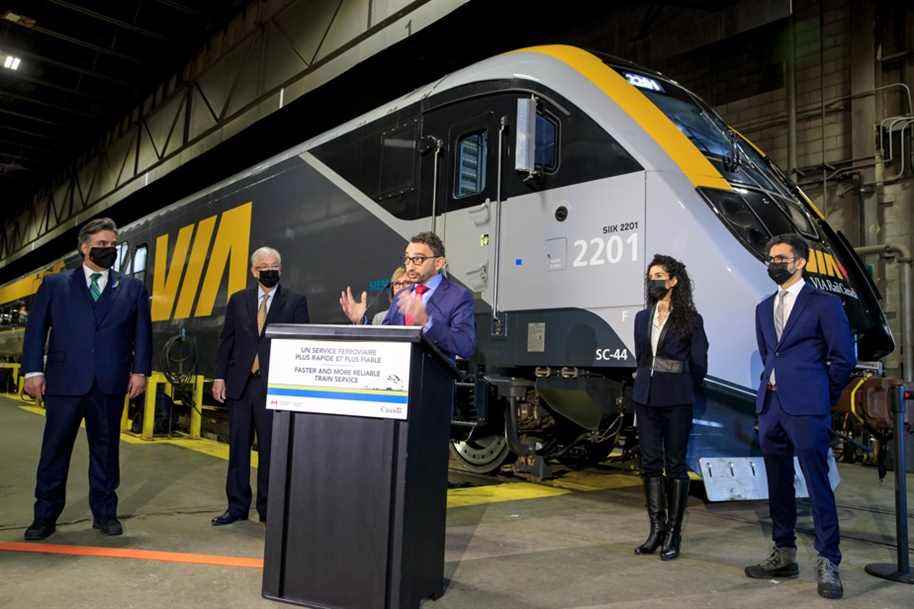The future high frequency train (TGF) is tinged with opacity according to the opposition parties who are urging the Trudeau government to explain why it will let the private sector decide the fares and schedules for this important project.
Posted at 4:25 p.m.
Ottawa wishes to entrust a “partner” with the operation of the VIA Rail trains which will run on the reserved corridor between Quebec and Toronto – the busiest and the most profitable for the Crown corporation. The Press saw this scenario when reading the Request for Expression of Interest — a document of about 75 pages that was quietly circulated over the past few days. No other options are considered.
“We are told ‘that’s what it is,’ affirms Alexandre Boulerice, deputy leader of the New Democratic Party. Have there been any comparative studies? Have other solutions been studied? We want answers. »
At a press conference in Montreal on March 9, the federal Minister of Transport, Omar Alghabra, had limited himself to inviting the private sector into the adventure, without offering more details.
The plan provides for the transfer of all VIA Rail services in the Quebec City-Toronto corridor to a subsidiary that will handle revenue collection. She will have her say on all aspects. If there are guidelines to be respected for fares and timetables, no details are provided.
Asked by The Press, transportation planning experts were surprised at the lack of details explaining the choice of Ottawa. The model in which a private company operates a public transport network exists elsewhere in the world.
Mr. Alghabra never explained in detail why this option was preferred. In an email on Friday, his cabinet limited itself to saying that the TGF was the “largest public transit infrastructure project” in Canadian history and that it had to be “done right”.
Several concerns
For VIA Rail employees, many questions remain unanswered. Everything indicates that they could be transferred to a new entity or end up with the partner that will be retained by Ottawa.
There was no public debate and all this information comes to us like a hair in the soup. What will happen to the employees? I have the impression that it’s a kind of red herring where we try not to disappoint them. I think there is a need to clarify things. My impression is that the government does not know where it is going. All we know is that he wants the private sector to operate the project.
Xavier Barsalou-Duval, Bloc Québécois Transportation Critic

PHOTO JUSTIN TANG, THE CANADIAN PRESS ARCHIVES
Bloc Québécois MP Xavier Barsalou-Duval
Transport Canada says there will be no “privatization of VIA Rail,” which operates intercity routes across the country.
“We will require that any agreement with a private sector partner respect collective agreements and benefits, demonstrate how the partner will work with VIA Rail employees and unions and ensure that current employees benefit from the employment opportunities that the project would offer,” said Minister Alghabra’s office.
According to its most recent annual report, VIA Rail has some 2,800 full-time workers.
“The Liberal government’s failure to provide meaningful information on how VIA Rail’s high-frequency rail corridor will be built and operated does not inspire confidence that this commitment will be met,” said the transportation official. to the Conservative Party, Melissa Lantsman.
The TGF would run on reserved railway tracks, which is not currently the case. The trains would run faster, up to 200 km/h, which should lead to gains on all routes. Montreal-Quebec would be done in 2 h 55 min or 3 h, rather than 3 h 24 min at present.

PHOTO FROM VIA RAIL WEBSITE
VIA Rail’s planned TGF network.
After mentioning a budget of 6 to 12 billion for the TGF last summer, Mr. Alghabra said he should not have come forward. The bill is therefore likely to be higher, but the minister no longer wants to talk about figures.
Learn more
-
- 2030
- The commissioning of the TGF is scheduled for the beginning of the next decade. Work should start around 2025.
government of canada

